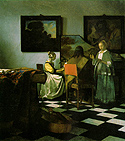Man linked to largest art heist in history freed from prison
HARTFORD, Conn. (AP) — A reputed Connecticut mobster who federal authorities believe is the last surviving person of interest in the largest art heist in history criticized government officials Monday as he adjusted to being back home after finishing a four-year prison sentence for weapons crimes.Robert Gentile, 82, also maintained he knows nothing about the unsolved theft of $500 million worth of art from the Isabella Stewart Gardner Museum in Boston in 1990. He was released from federal custody in the unrelated weapons case Friday.
He also blamed federal prison officials for worsening health problems that have left him unable to get around except in a wheelchair, and he criticized law enforcement officials for seizing his money and damaging his home during a raid in the weapons case.
Officials with the Federal Bureau of Prisons said they were reviewing Gentile's comments but had no immediate response Monday. An FBI spokesman in New Haven declined to comment.
Update:
Federal prison officials say there is no evidence to support mistreatment allegations made by a reputed Connecticut mobster who authorities believe is the last surviving person of interest in the largest art heist in history.
The federal Bureau of Prisons said in a statement Monday that it could find no support for the allegations.
"Mr. Gentile went to prison, he's been released, the investigation goes on. We're not sitting around hoping he tells us what he may or may not know." Anthony Amore Director of Security Gardner Museum
The art heist took place March 18, 1990, when two men masquerading as Boston police officers got into the museum by telling a security guard they were responding to a report of a disturbance, according to authorities. The guard and a co-worker were handcuffed and locked in the basement while the thieves made off with the art.
The missing pieces include Rembrandt's only known seascape, "Christ in the Storm on the Sea of Galilee," and Vermeer's "The Concert," one of fewer than 40 known paintings by the 17th-century Dutch painter.
The FBI told The Associated Press in 2015 that two suspects — both Boston criminals with ties to organized crime — were deceased.
Investigators believe the paintings moved through mob circles to Connecticut and Philadelphia, where the trail went cold, officials have said.
Prosecutors have said another gangster's widow claimed her husband gave Gentile two of the paintings. Authorities also have said that Gentile talked about the stolen paintings with fellow prisoners and once told an undercover FBI agent he had access to two of the paintings and could negotiate the sale of each for $500,000.
Federal agents have searched Gentile's home three times, including with ground-penetrating radar, in what Gentile's lawyer, A. Ryan McGuigan, believes were efforts to find the paintings and other evidence about the heist.
The weapons charges were filed after authorities found several firearms at Gentile's home in 2016, which he was prohibited from possessing as a previously convicted felon.
Gentile was sentenced to more than two years in prison in 2013 for illegally selling prescription drugs and possessing guns, silencers and ammunition. In that case, prosecutors said federal agents found in Gentile's home a handwritten list of the stolen paintings and their estimated worth, along with a newspaper article about the museum heist a day after it happened.



1 comment:
Great read thanks for writing this
Post a Comment